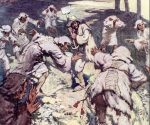Herodotus tells us that the major pyramids at Giza were built approximately 800 BC
Everyone knows about the three major pyramids at Giza in Egypt. Everyone knows that they were built around about two and half thousand years BC by three pharaohs of the Fourth Dynasty. Undoubtedly, there seems to be a lot of certainty surrounding the genesis of the pyramids; and somewhat perversely, this assuredness raises doubt. The reader will undoubtedly have come across some researchers and writers who raise the following particular question: how were such monumental and straight–edged stone buildings manufactured with only rudimentary cutting tools available? Others notice how the Giza pyramids are superb compared to slightly earlier ones that are nowhere near as excellently executed, and this suggests another mystery: how did the Egyptian art of pyramid-building evolve so abruptly to perfection?
There can be no mystery if one comes at the subject forgetting everything one has ever learned about it. The answer to the riddle of the pyramids is that they must have been built when the iron tools to process the stone became available. Furthermore, the three major pyramids at Giza must have been built when the technical skill to plan and erect them had had sufficient time in human experience to develop into the ability to produce a masterpiece. In other words, the three greater Giza pyramids were built later than we have been told. This shouldn’t be as crazy a notion as it sounds, after all, if we were sufficiently well read we would all know that the father of history, Herodotus, told us that the pyramids were indeed built much later than is universally credited.
In his Histories, Herodotus lists eleven Egyptian kings as told to him by people who were priests of that country around about the mid-fifth century BC. It appears from the way the list is presented that Herodotus believes that every king after the first succeeded the one before him, so we should see each name in the list as a real human being rather than representative of a house or a dynasty, and the list as describing eleven consecutive reigns.
This is the list:
Sesostris, Pheros, Proteus, Rhampsinitus, Cheops, Chephren, Mycerinus, Asychis, Anysis, Sethos and Psammetichus.
The last individual in that list, Psammetichus, is universally identified as Pharaoh Psamtik I, the founder of the 26th Dynasty, who ruled 664-610BC. We can be sure of these dates because they are constituent to data that appears to be the only point of exact agreement between what is known as the Old Chronology (OC) for dating Egyptian history and the New Chronology (NC). This article can’t be written unless there is a mention of the distinction between the two. The NC is a 20 year old upstart developed chiefly by David Rohl, amongst a few others, that allows the history of pan-antiquity to fit together. The Old Chronology survives by being strict Victorian orthodoxy that none should dare to question, and that was conceived in self-evidently dubious ways. That the Old Chronology is still dominant appears to the author to be down to a refusal to concede, and a testimony to the tyrannical power of a self-interested establishment that has way far too much to lose by having its world view demolished.
Back to the king list, though, and to its top; Sesostris had already been linked to the famous Ramesses II before the NC, but it is the NC that enables a definite identification. Herodotus tells us that Sesostris launched a military expedition and penetrated as far as Scythia and Thrace (the Caucuses and the European side of the Black Sea), which is an unequalled piece of martial prowess. The Egyptian records tell of the extensive conquests of Ramesses II (or Riamashesha). And then there is a third character recorded in writings: the biblical Shishak who invaded Judah and removed treasures from Solomon’s Temple. All these are one and the same (please see Rohl’s “From Eden to Exile” for a full demonstration of how Ramesses and Shishak equate to the same individual). And so the NC brings the 19th Dynasty (962-829 BC) closer to the 26th, and it allows us to place Psammetichus in the scheme of things only a couple of handfuls of generations after Ramesses II, instead of half a millennium – as is the case in the OC. In terms of analysing Herodotus’ king list for the purposes of this article, this is the bare minimum that needs to be done, but faces are going to be put to the other names too.
If Sesostris is Ramesses II (943-877 BC), then it follows that Pheros must be Merneptah (888-875 BC) who was a co-regent for most of his life, and came to rule on his own very late and for a short time. Maybe this is reflected in the passive tone used by Herodotus: “After Sesostris’ death, his son Pheros inherited the kingdom”. Merneptah was apparently involved in fending off Libyan attacks during the co-regency, although Herodotus says that Pheros didn’t have any military adventures at all. In fact, Herodotus tells of how Pheros was blind for 10 years (before curing himself with a urine wash). At the end of Merneptah’s reign, and as a reflection of the old man’s weakness, there emerged a pretender to the throne, Amenmesse. (It could in fact be that Amenmesse is Pheros if you count the reigns of Merneptah and Ramesses as one).
Herodotus continues: “The priests told me that after Pheros the kingdom passed to a man from Memphis whose name in Greek is Proteus.” What this could reflect is the NC assertion that the 19th Dynasty continued alongside a new one – the 20th Dynasty (855-740 BC), ruling from a different power base, and which had little or no familial connection with Pheros. Proteus, then, would be Setnakhte, the father of Ramesses III or Rhampsinitus (the similarity in the name is obvious). Herodotus says that Proteus took the side of the Greeks in the matter of Helen of Troy (could this have anything to do with his coming to power?). As for Rhampsinitus, Herodotus tells that he was extremely wealthy, and Egypt did well up to the end of his reign (pretty much echoed in conventional Egyptology – he was “the last New Kingdom king to wield any substantial authority over Egypt”)
Herodotus says that the immediate descendents of Rhampsinitus were tyrants, the first being Ramesses IV – Amonhirkhopshef (Cheops) as he was known as a Crown Prince during the reign of his father. In official Egyptology Ramesses IV initiated a building programme on a substantial scale. This is reflected in Herodotus who tells of how Cheops set 100s of thousands of people to work on his projects (huge monument building projects are nearly always about oppressing a populace, in the opinion of the author). And in confirmation of the kind of king he was, and the financial disarray the country was in, Herodotus tells us Cheops forced his daughter into prostitution to raise money.
The next king was Ramesses V, or Sekheperenre Ramesses V (Chephren) to give him a fuller title; he was the son of Ramesses IV. Official Egyptology tells us that during this reign, the priests of Amun became more powerful (richer, and in possession of more taxed land) at the expense of the pharaoh. Again, this is confirmed by Herodotus who tells of how the people in the country became grievously miserable.
The next pharaoh was Ramesses VI, or Ramesses VI Nebmaatre-Meryamun (Mycerinus). He was the son of Ramesses III, so the brother of Ramesses IV. This character may well of raped his own daughter, according to Herodotus. We should note that Herodotus says that Chepren was Cheops’ brother, and that Mycerinus was Cheops’ son.
The author would like to link the next of Herodotus’ kings, Asychis, with the Pharaoh Piye, or Piankhi, the founder of the 25th Dynasty ruling out of Nubia, or Ethopia. This idea would be contentious with all of Egyptology – the NC has the 25th Dynasty start at 741BC, but Herodotus tells us that Asychis built a brick pyramid, and Piye actually did build a pyramid, and according to the orthodoxy, it was a major one and thus unusual for the epoch. But because Piye was apparently quite long-lived, and thus potentially knocking around across the good part of a century, it occurred to the author that he could actually have been Asychis founding his dynasty in Egypt before 823 BC to run simultaneously with other dynasties that the NC identifies to be extant at the time.
The next Pharaoh that Herodotus mentions is Anysis. The author thinks this must be Shoshenk I (823-803 BC), or Sesonkhosis, for the following reason. Shoshenk was the founder of the 22nd Dynasty which originally ruled out of Bubastis, which is in the Nile Delta. Herodotus talks about Anysis withdrawing into the marshlands after an invasion by an Ethiopian, Sabacos, and talks about Bubastis being raised up by excavation. Herodotus says that Sabocos left Egypt voluntarily, after which Anysis resumed being pharoah. It turns out that Sabacos is probably Shabaka, the historical brother of Piye. So, could Herodotus be telling us about a power struggle where Shoshenk becomes the dominant force in Egypt prompting a re-invasion by the Ethiopians to reinforce the 25th Dynasty? Shoshenk hadn’t been as helpless as Anysis in Herodotus’ story because he launched a military offensive into Israel (prompting orthodox Egyptologists to confuse him with Ramesses II).
Shabaka seems to have ruled with Shebitku, a son of Piye, in a co-regency. But the penultimate king in Herodotus’ list, Sethos, is prohbably Shebitku’s brother, Taharqa (690 – 664 BC), who is referred to as Tirhakah, King of Ethiopia, in 2 Kings 19:9 – an enemy of the Assyrian king Sennacherib at the time of Hezekiah. He also appears in Josephus, who quotes Herodotus, but uses the name Trihaka, King of the Ethiopians. He clearly believes that Herodotus’ Sethos is a reference to the same person. In Herodotus, Sethos was a priest of Hephaestus who appealed to his god to aid against an invasion by Sennacherib. In Josephus, Trihaka prays to God.
Now to the crux of the matter. The historical scheme interpreted from Herodotus by the author is obviously not a serious proposal of the history of the New Kingdom and Third Intermediate periods of Egypt. It’s a casual thought experiment and a suggestion of a possibility based on a little research, and there would have to be much, much more research to do to prove any of it. The purpose of dedicating this much white space to it has been to show that we could reasonably accept Herodotus’ king list as an inventory of kings succeeding immediately one after another from 943BC to 610BC. Eleven in 333 years gives an average reign for each of 30 years (and actually a period before Psamtek, where there was no one dominant king of Egypt, has been omitted).
All this now builds up to what should be a bombshell for anyone reading The Histories for the first time: Herodotus also tells us that the three major pyramids at Giza were built by Cheops, Chephren and Mycerinus, who appear right in the middle of his king list. He clearly isn’t referring to any 4th Dynasty pharaohs who, according to modern archaeologists, are supposed to have built them because we can identify the historical context in which he places the three kings. And don’t forget that Herodotus isn’t remote to this history. He has proximity to it like modern English have to the Georgians.
And yet despite this we somehow know the pyramid builders as pharaohs Khufu, Khafre and Menkaure. When Victorian archaeologists were looking for proof of the builders of the pyramids – for there are no carvings anywhere on the structures – they were looking for Khufu, Khafre and Menkaure (Herodotus actually explains why the pyramids might have ended up as anonymous: “the Egyptians loathe Chepren and Cheops so much that they really do not like to mention their names”).
The author assumes that the hypothesis of ownership must have been generated by other findings in the vicinity – of which, apparently, there were plenty – and then the names of Herodotus’ three kings were deemed close enough to justify the attribution. Amazingly, having used Herodotus in this way, his placing of the pyramids in (relative) modernity is just discarded, as is information about how the pyramids were built – which was a particularly foolish thing to throw away because it would have spared us endless TV documentaries about how the pyramids might have been built by aliens.
The attribution of the Great Pyramid to Khufu apparently relies on a cartouche in paint marked on masonry in an internal chamber (and assumedly the other two pharaohs just inherited theirs by association). Apparently, calling the cartouche a fake is frowned upon (as well it might be), but there definitely is controversy that shouldn’t just be swept under the carpet, as one website dedicated to the matter explains here. The author is in no position to make a comment, but notes it must be much easier for one of those unscrupulous early archaeologists, otherwise unskilled in stone masonry, to fake daubs in paint than to knock up an authentic-looking staela.
Of course, everyone thinks suggestion of a hoax to be unreasonable when they first encounter it: why would anyone what to create and sustain any horrible fraud and deceive so many people? The answer would be really quite simple. Firstly, people who want power will look to create situations where they have knowledge which is kept from the masses. It doesn’t matter what the lie is about. It’s about a kind of Magic that is generated from knowing reality, and making the masses believe in a fantasy. Someone with a grip on reality can occasionally project it into the mass delusion to win adoration or respect (think of ancient priests who had the power to block the sun during the day: in reality an eclipse). Secondly, if there is money in a fraud – which there usually is – there will always be people corrupt enough to perpetrate one and sustain it. Think of the industry that is propelled by the ongoing mystery of the Giza Pyramids. Thirdly, if people have committed a crime, they obviously cover it up.
But deciding that we have been fooled about the pyramids, which can’t be proven, is not the actual point of this article. It’s about the absolute crucial necessity of taking an alternative approach to gaining and possessing knowledge. The abuse of knowledge is something that happens all the time, for the reasons given above, and people must be aware of it because to be ignorant is to be prey – and we shouldn’t want to be that. Automatically do not trust whatever the authority tells you to be true. Go and look at the resources that they don’t let you know about, or have interpreted for you, or are older than the 20 years of age that university professors actively discourage students from looking at to ensure a Marxist indocrination. These sources are often there if you look, waiting to be found. Look to discover tools to aid your understanding, whether it be another language, or as in this case, an alternative system of chronology for Egyptology.
Being informed in this way makes us into critical thinkers who can’t then be duped by a Priesthood guarding secret knowledge. And then we can discover, for instance, that Global Warming is not actually a fact beyond debate, and we can discover that the WTC towers (all three of them), if they had merely been struck by two planes, just cannot collapse as if they had been demolished with placed explosives, and we can discover that, if it then appears quite intact in footage of his arrest, Michael Adebowale couldn’t have lost a thumb to a shot fired at him by an armed policeman.


















